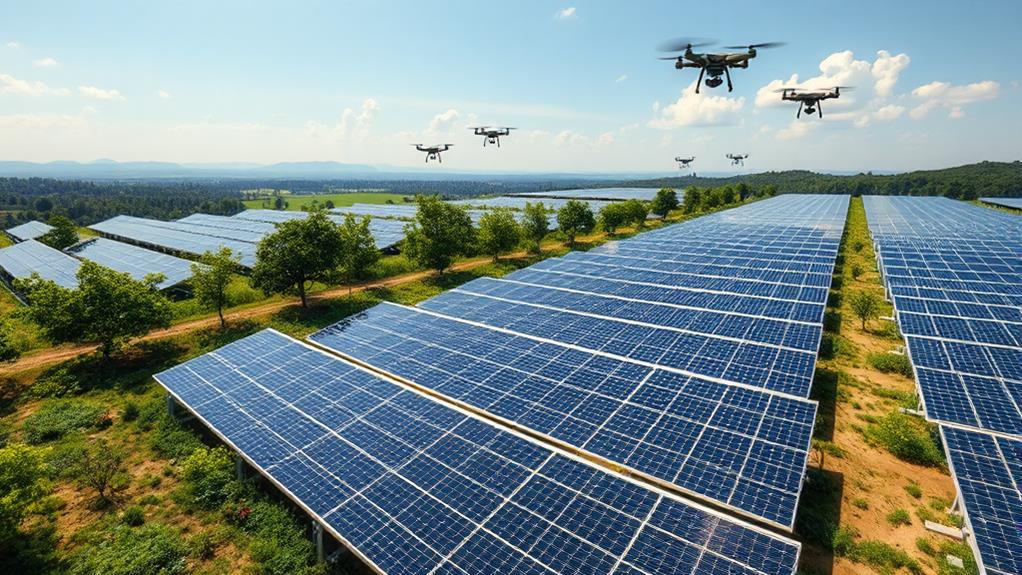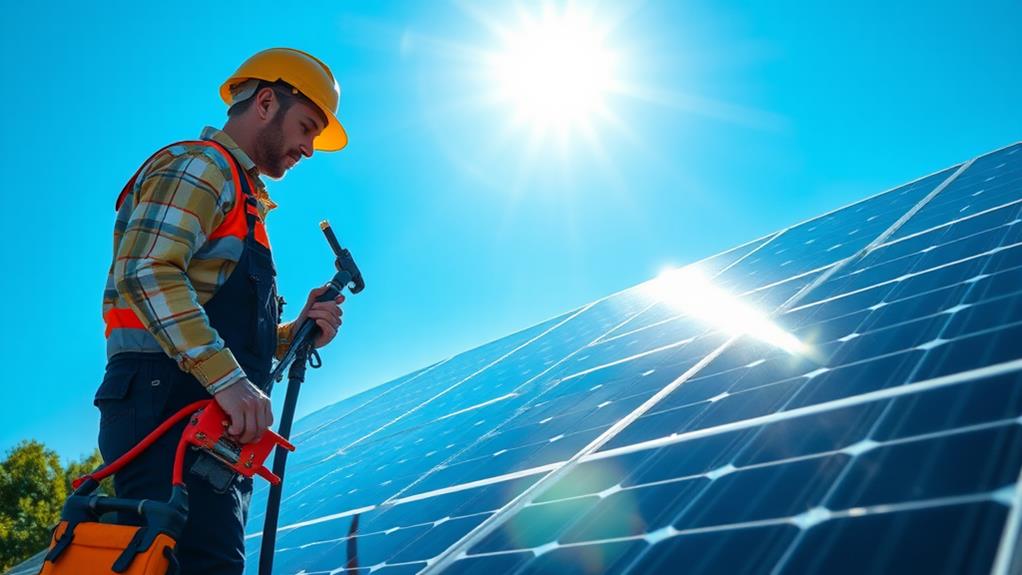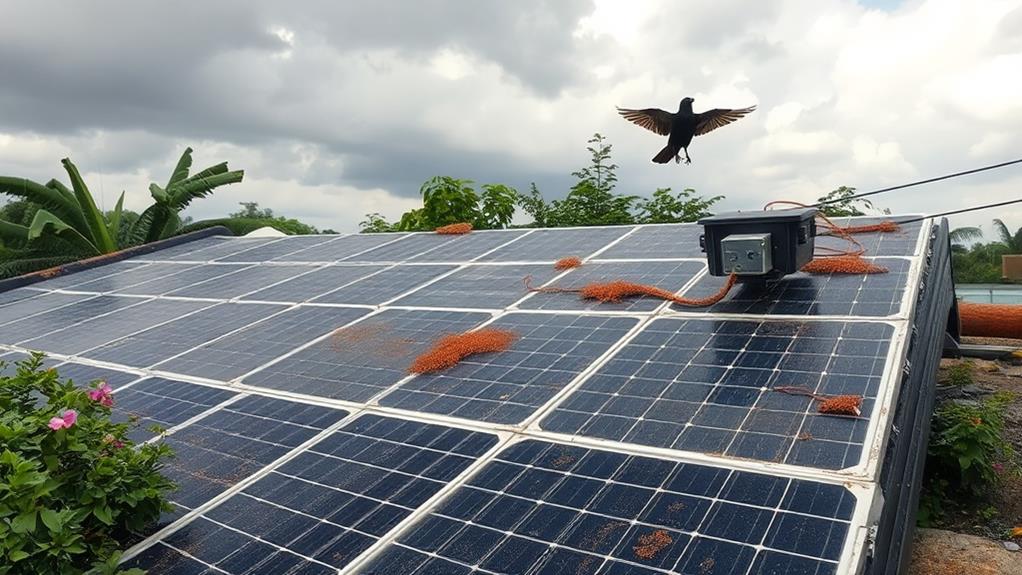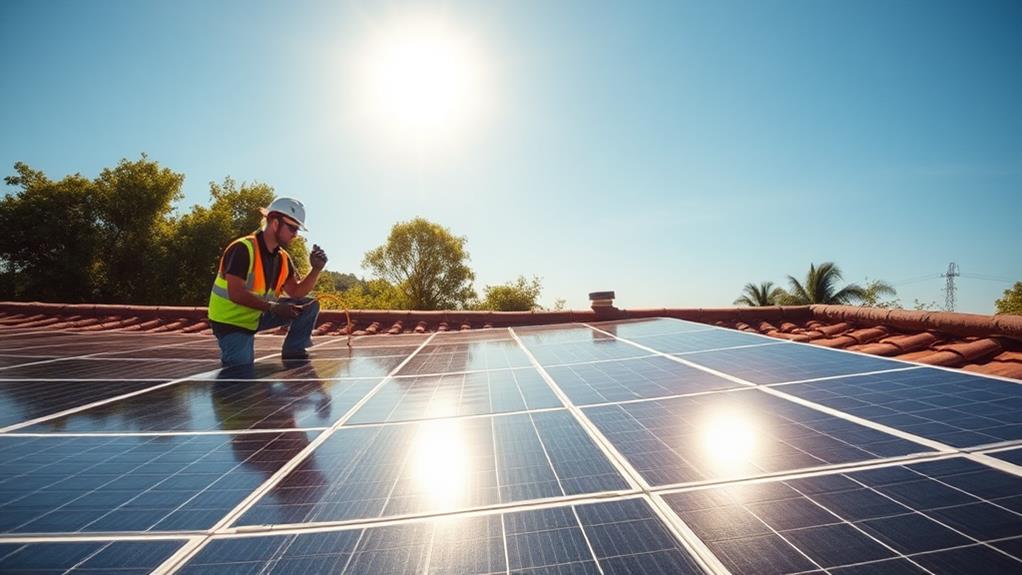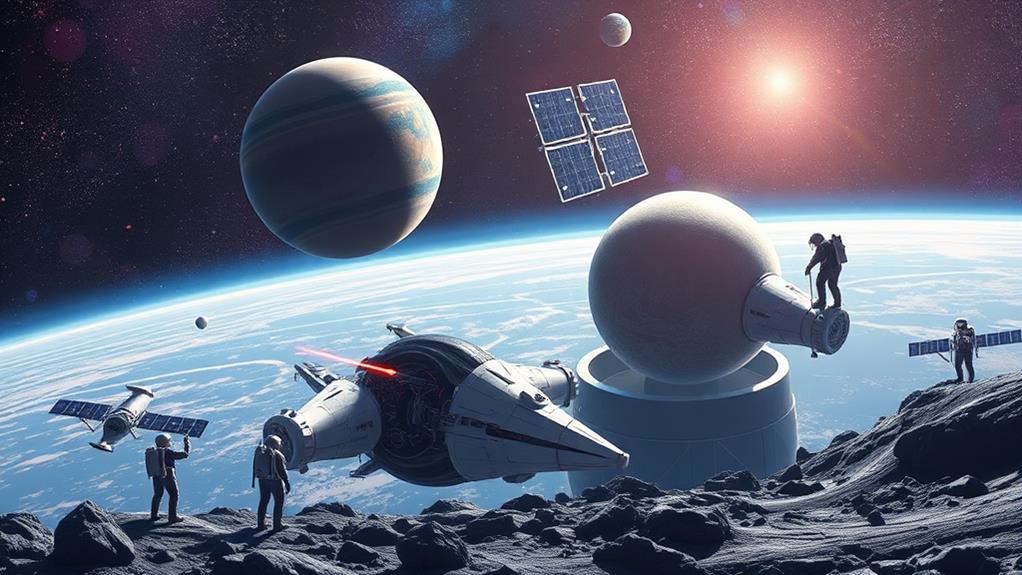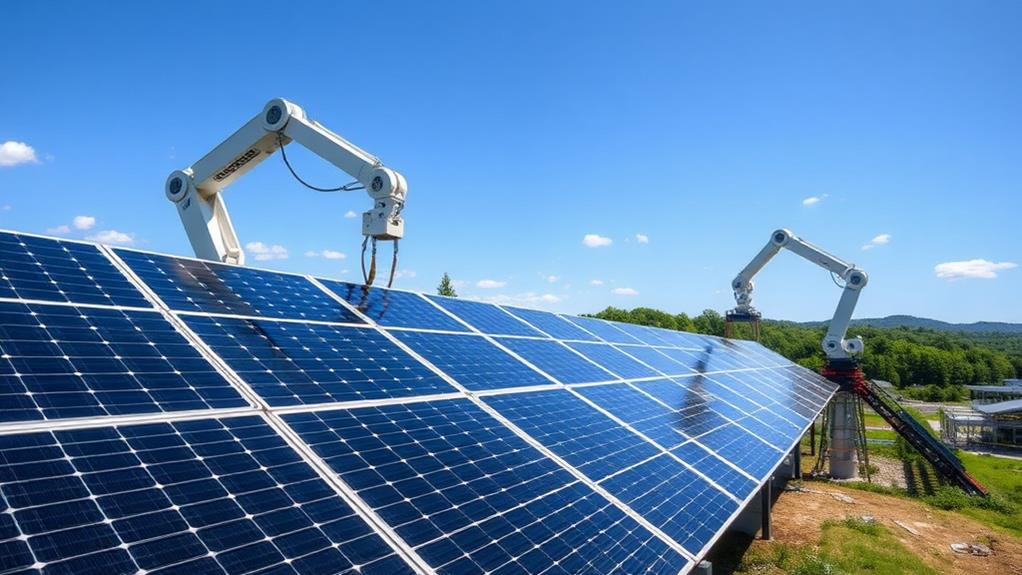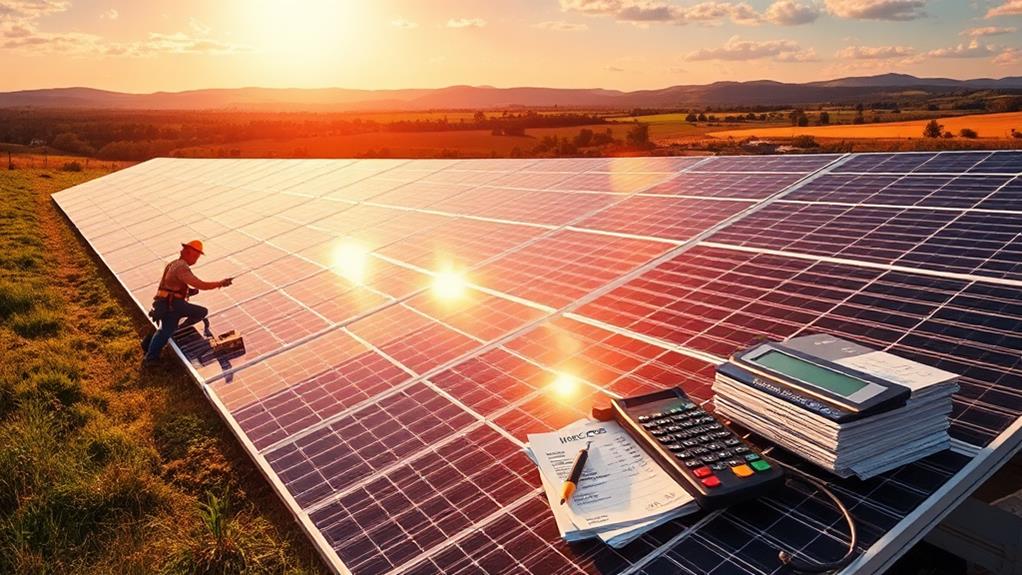We're witnessing exciting trends in solar mounting technology that hold the potential to reshape the future. Lightweight, modular designs like those from Schletter Group and K2 Systems make installations easier and more customizable. Adjustable systems, utilizing dual-axis tracking and smart technologies, optimize sunlight absorption significantly, while integrating IoT enriches real-time monitoring and smart grid connections. Sustainable materials, including upcycled aluminium and bamboo, align with eco-friendly goals and reduce environmental impact. The market is expanding, driven by increasing renewable energy demands, with innovations from companies like Nextracker leading the way. There's much more to discover about these evolving technologies and their implications.
Key Takeaways
- Lightweight, modular designs enhance customization and reduce transportation costs using materials like aluminium and composites.
- Adjustable systems with dual-axis tracking increase energy output by up to 25% through optimal sunlight absorption.
- Integration of smart technology enables real-time monitoring, energy management, and connection to smart grids for improved distribution.
- Sustainable materials, like recycled aluminium and bamboo, support eco-friendly practices and circular economy initiatives.
- Market growth driven by demand for renewable energy, with significant expansion in Asia-Pacific and North America regions.
Lightweight and Modular Designs
In the rapidly evolving solar industry, a noteworthy shift towards lightweight and modular designs in mounting technology is apparent. The focus is on creating systems that truly cater to diverse needs. With materials like aluminium and composites, the weight of these systems has been significantly reduced, making installation easier and quicker. This weight reduction simplifies handling and decreases transportation costs, a benefit for all stakeholders.
Modular designs offer remarkable customisation options. Solar mounting systems can now be tailored to meet unique installation requirements. Whether dealing with varying panel sizes or distinct configurations, modular components provide essential flexibility. This customisation enhances installation efficiency and ensures each project is optimised for the best possible outcome.
For example, the Schletter Group offers the AluGrid 2.0 system, known for its lightweight aluminium construction and modular approach, making it ideal for flat roofs.
Another excellent product is the K2 Systems' Dome 6.10, a modular system crafted to accommodate different panel sizes effortlessly.
These innovative designs not only meet current demands but also set the stage for future advancements in solar technology.
Adjustable System Innovations
Adjustable system innovations in solar mounting technology represent a significant advancement in energy efficiency. Adopting these improvements places us within a community focused on maximising solar power's potential. Adjustable solar mounting systems dynamically position panels to track the sun's movement, significantly enhancing energy production. They can increase energy output by up to 25% compared to fixed systems, providing a cost-effective efficiency that's difficult to ignore.
One remarkable development is the dual-axis tracking system, which adjusts both vertically and horizontally, ensuring panels absorb maximum sunlight. This adaptability not only boosts energy capture but also demonstrates the enhanced performance of solar installations.
Advanced control systems in these mounts utilise cutting-edge sensors and algorithms, precisely positioning panels to make the most of every ray of sunshine.
The flexibility of these adjustable systems makes them suitable for a variety of installation sites and environmental conditions. Tailored solutions ensure optimal energy generation wherever they're set up. The First Solar Series 6 is a prime example of the technology leading the charge in this area. We're harnessing the power of innovation to create a sustainable future, one panel at a time.
Smart Technology Integration
The integration of smart technology in solar solutions marks a pivotal moment in the evolution of solar mounting systems. Real-time monitoring and energy management are now standard, fostering a deeper connection with our energy resources. IoT-equipped smart solar panels, such as the SunPower Performance Series, ensure optimal orientation and sunlight tracking, enhancing electricity output for communities.
Smart technology extends beyond the panels themselves. Connection to smart grids improves energy distribution and encourages active engagement with energy consumption patterns. Consumers are no longer passive; they're integral to the energy ecosystem. Automation and data analytics support these systems, ensuring peak performance and reliability, which offers peace of mind and a sense of community involvement.
Advancements in solar mounting technology significantly boost the efficiency and effectiveness of solar energy systems. Embracing these innovations means participating in a sustainable future. Each individual contributes to smarter energy use, paving the way for a greener tomorrow.
Sustainable Material Solutions
The shift towards renewable energy is accelerating, and sustainable materials in solar mounting technology are crucial. Recognising the need to integrate materials that support energy efficiency and align with environmental principles is vital.
Recycled aluminium stands out due to its significantly reduced environmental impact during production, requiring less energy than new aluminium. This choice not only lowers carbon emissions but extends the lifecycle of existing materials, promoting sustainability.
Bamboo-based mounting systems present an innovative solution. Bamboo's rapid growth and renewable nature make it an exemplary choice for those prioritising sustainability. It provides a durable and environmentally friendly alternative to traditional materials, advancing sustainable practices in solar installations.
Incorporating composite materials enhances the durability and longevity of solar mounting structures. This advancement not only prolongs their lifespan but also aligns with the circular economy approach. Adopting these sustainable solutions can foster a sense of community among those dedicated to renewable energy progress.
For example, the EcoMount Bamboo Solar Mounting System offers a reliable and eco-friendly option for installations. Additionally, the GreenTech Composite Solar Mount is known for its robustness and sustainability, supporting the transition to greener energy solutions.
Environmental Impact Considerations
As we delve into the future of solar mounting technology, let's consider the crucial role of sustainable materials selection. By opting for lightweight and recyclable materials, we not only decrease the carbon footprint but also improve the lifecycle impact of solar installations.
It's vital that we evaluate every stage of a mounting system's life to truly minimize environmental strain and promote biodiversity conservation.
Sustainable Materials Selection
Selecting sustainable materials in solar mounting technology is essential to reduce the environmental impact of solar installations. Our commitment to eco-friendly solutions highlights the importance of choosing materials that enhance solar system performance while supporting circular economy practices.
Aluminium is a popular choice due to its lightweight nature, recyclability, and corrosion resistance. These attributes make it an excellent candidate for sustainable solar mounting structures, aiding in reducing our environmental footprint.
Steel's durability and strength, along with its recyclability, present another viable option for these systems. Choosing steel supports the longevity and sustainability of solar installations, aligning with our goal of fostering a greener future.
The incorporation of recycled materials, such as plastics or metals, into our mounting systems further minimises waste and promotes resource efficiency.
Aiming for green building certifications, selecting sustainable materials becomes crucial. Prioritising these choices not only reduces the carbon footprint of our solar installations but also cultivates a sense of belonging within our environmentally conscious community. Together, we can make a significant impact.
Lifecycle Impact Assessment
Evaluating the complete life cycle impact of solar mounting technologies is essential to understanding their environmental footprint. Life cycle impact assessments allow us to assess energy consumption, emissions, and resource depletion throughout the entire lifespan of these systems, from production to disposal. Analysing these factors helps implement energy efficiency strategies that enhance the performance of solar mounting systems and align with green building certifications. These certifications are crucial, demonstrating dedication to sustainable practices and creating a sense of belonging within a global community committed to environmental stewardship.
Assessment involves examining production, transportation, installation, operation, and disposal processes. Optimising material usage and reducing energy consumption can significantly diminish the environmental impact. Such thorough evaluations reveal opportunities for sustainability improvements, like promoting recycling and innovative disposal methods. Understanding these impacts is vital for achieving long-term environmental sustainability in the renewable energy sector.
Individual and collective actions can encourage the adoption of eco-friendly practices within the solar industry. Aligning with community objectives contributes to a more sustainable future, ensuring solar mounting technologies support sustainable progress for future generations. For instance, incorporating products like the Schletter PV Max mounting system, which uses recycled materials and boasts a longer life span, can lead to substantial environmental benefits.
Additionally, selecting local suppliers to minimise transportation emissions further supports sustainability goals.
Global and Local Market Trends
The solar mounting technology market is experiencing significant growth on both global and local scales. There's an observable expansion, especially in regions such as Asia-Pacific and North America, driven by the increased demand for renewable energy. These areas favour fixed mounting systems, which currently hold a dominant 60% market share. Ground power stations are prominent, accounting for about 70% of applications.
Technological advancements are leading to more efficient and sustainable solutions. The market is prioritising lightweight materials and smart technologies to address installation challenges. These innovations not only reduce costs but also improve the overall efficiency of solar systems.
Companies like Nextracker, Arctech Solar Holding, and Canadian Solar are at the forefront of this transformation, capturing approximately 25% of the global market share.
As the world shifts towards a greener future, understanding these trends connects us to a global movement. Embracing these developments means joining a community dedicated to sustainability and innovation in solar technology.
Conclusion
As we look into the future of solar mounting technology, lightweight, modular designs and adjustable systems are leading the way. By using smart technology and sustainable materials, we're not just innovating; we're making a positive impact on the environment. Staying informed about global and local market trends ensures we remain at the forefront of change.
At Deo Solar, we invite you to reach out if you have any questions about our products, such as Rail-Less Solar Brackets, End Spacers, Structural Brackets, Ground Mounted Solar Systems, Corrugated Brackets, and Earthing Plates. We also offer services like the DeoSizer Tool, Evaluation and Design, Maintenance and Support, and Solar Installations. Together, we can embrace these advancements and contribute to a more sustainable and efficient solar energy future. Please contact us to learn more about how we can help you.

